2014 AUDI RS7 SPORTBACK roof
[x] Cancel search: roofPage 71 of 292
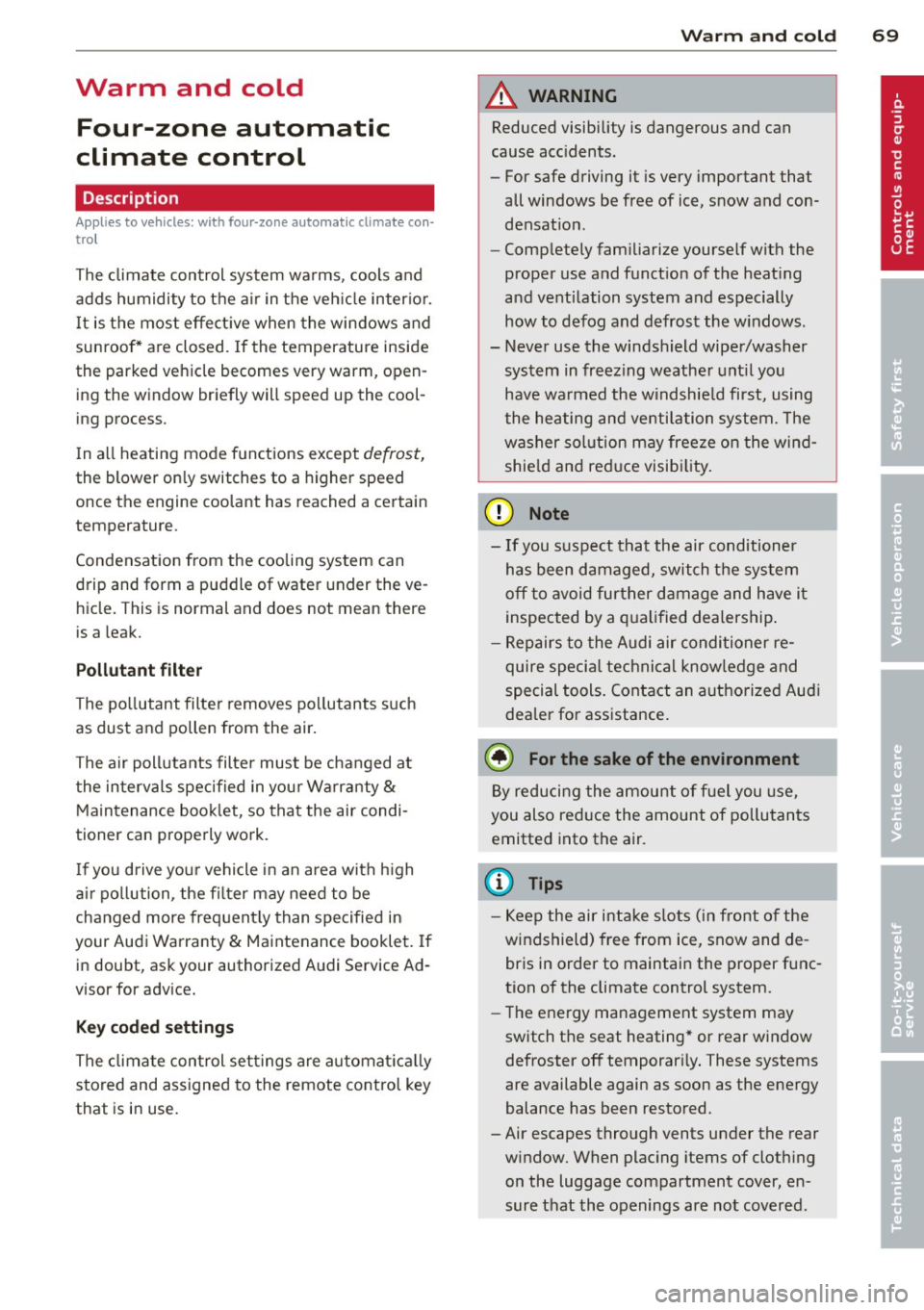
Warm and cold Four-zone automatic
climate control
Description
Applies to vehicles: with four-zone automat ic climate co n
tro l
The climate control system warms, cools and
adds humidity to the a ir in the veh icle inter io r.
It is the most effect ive when the windows and
sunroof* are closed.
If the temperature inside
the parked vehicle becomes very warm, open ing the window briefly will speed up the cool
ing process.
I n all heating mode functions except
defrost,
the blower on ly switches to a higher speed
once the engine coolant has reached a certain
temperature.
Condensation from the cooling system can
drip and form a puddle of water under the ve
hicle. This is normal and does not mean there
is a leak.
Pollutant filt er
The po llutant filter removes pollutants such
as dust and pollen from the air.
The air pollutants filter must be changed at
the intervals spec ified in your Wa rranty
&
Maintenance book let, so that the air condi
tioner can properly work.
I f you d rive your vehicle in an area with h igh
air po llution, the fi lter may need to be
changed more frequent ly than specified in
your Audi Warranty
& Maintenance booklet. If
in doubt, ask your authorized Audi Service Ad·
visor for advice.
Key coded setting s
The clima te control sett ings are a utomat ica lly
stored and assigned to the remote contro l key
that is in use .
Warm and c old 69
A WARNING
-
Reduced visibi lity is dangerous and can
cause acc idents .
- For safe driving it is very important that
all windows be free of ice, snow and con
densat ion.
- Comp letely fam il iarize yourse lf with the
proper use and funct ion of the heat ing
a nd ventilation system and especially
how to defog and defrost the w indows.
- Never use the windshield wiper/washer system in freez ing weathe r unt il you
have warmed the windshie ld first, using
the heating and ventilation system. The
washer sol ution may freeze on the wind
shie ld and red uce visibi lity.
CJ) Note
- If you s uspect that the air conditioner
has been damaged, switch the system
off to avoid furt her damage and have it
inspected by a qualified dea lership .
- Repairs to the Audi air conditioner re
quire specia l technical know ledge and
special tools. Contact an authorized Audi
dealer fo r ass istance.
@ For the sake of the envi ronment
By reducing the amount of f uel you use,
you also red uce the amount of pollutants
emitted into the air.
(D Tips
- Keep the air intake s lo ts ( in front of the
w indshield) free from ice, snow and de
bris in order to maintain the proper func
tion of the climate control system.
- The energy ma nagement system may
switch the seat heating* or rear window defroster off temporar ily. These systems
are available again as soon as the energy
balance has been restored .
- Air escapes through vents under the rear window. When plac ing items of cloth ing
on the luggage compartment cover, en
sure that the openings are not covered.
Page 132 of 292

130 Driving Safely
&_ WARNING
-
To help prevent poisonous exhaust gas
from being drawn into the vehicle, always keep the rear lid closed while driving .
- Never transport objects larger than
those fitting completely into the luggage
area because the rear lid cannot be fully
closed.
- If you absolutely must drive with the rear
lid open, observe the following notes to
reduce the risk of poisoning:
- Close all windows,
- Close the power roof*,
- Open all air outlets in the instrument
panel,
- Switch off the air recirculation,
- Set the fresh air fan to the highest
speed.
&_ WARNING
Always make sure that the doors, all win
dows, the power roof* and the rear lid are
securely closed and locked to reduce the
risk of injury when the vehicle is not being
used.
- After closing the rear lid, always make
sure that it is properly closed and locked.
- Never leave your vehicle unattended es
pecially with the rear lid left open. A
child could crawl into the vehicle through
the luggage compartment and close the
rear lid becoming trapped and unable to
get out . Being trapped in a vehicle can
lead to serious personal injury.
- Never let children play in or around the
vehicle .
- Never let passengers ride in the luggage
compartment . Vehicle occupants must
always be properly restrained in one of
the vehicle's seating positions.
(D) Tips
- Air circulation helps to reduce window fogging. Stale air escapes to the outside
through vents in the trim panel. Be sure
to keep these slots free and open .
-
-The tire pressure must correspond to the
load. The tire pressure is shown on the
tire pressure label. The tire pressure la
bel is located on the driver's side B-pillar.
The tire pressure label lists the recom mended cold tire inflation pressures for
the vehicle at its maximum capacity
weight and the tires that were on your
vehicle at the time it was manufactured.
For recommended tire pressures for nor
mal load conditions , please see chapter
r::!) page 232.
Tie-downs
The luggage compartment is equipped with
four tie-downs to secure luggage and other
items.
Use the tie-downs to secure your cargo prop
erly ¢
page 129, Loading the luggage com
partment.
In a collision, the laws of physics mean that
even smaller items that are loose in the vehi
cle will become heavy missiles that can cause
serious injury. Items in the vehicle possess en
ergy which vary with vehicle speed and the
weight of the item. Vehicle speed is the most
significant factor.
For example , in a frontal collision at a speed
of 30 mph (48 km/h), the forces acting on a 10-lb (4.5 kg) object are about 20 times the
normal weight of the item. This means that
the weight of the item would suddenly be about 200 lbs. (90 kg). You can imagine the
injuries that a 200 lbs . (90 kg) item flying
freely through the passenger compartment
could cause in a collision like this.
&_ WARNING
Weak, damaged or improper straps used
to secure items to tie-downs can fail dur
ing hard braking or in a collision and cause
serious personal injury.
- Always use suitable mounting straps and properly secure items to the tie-downs in ..,.
Page 147 of 292
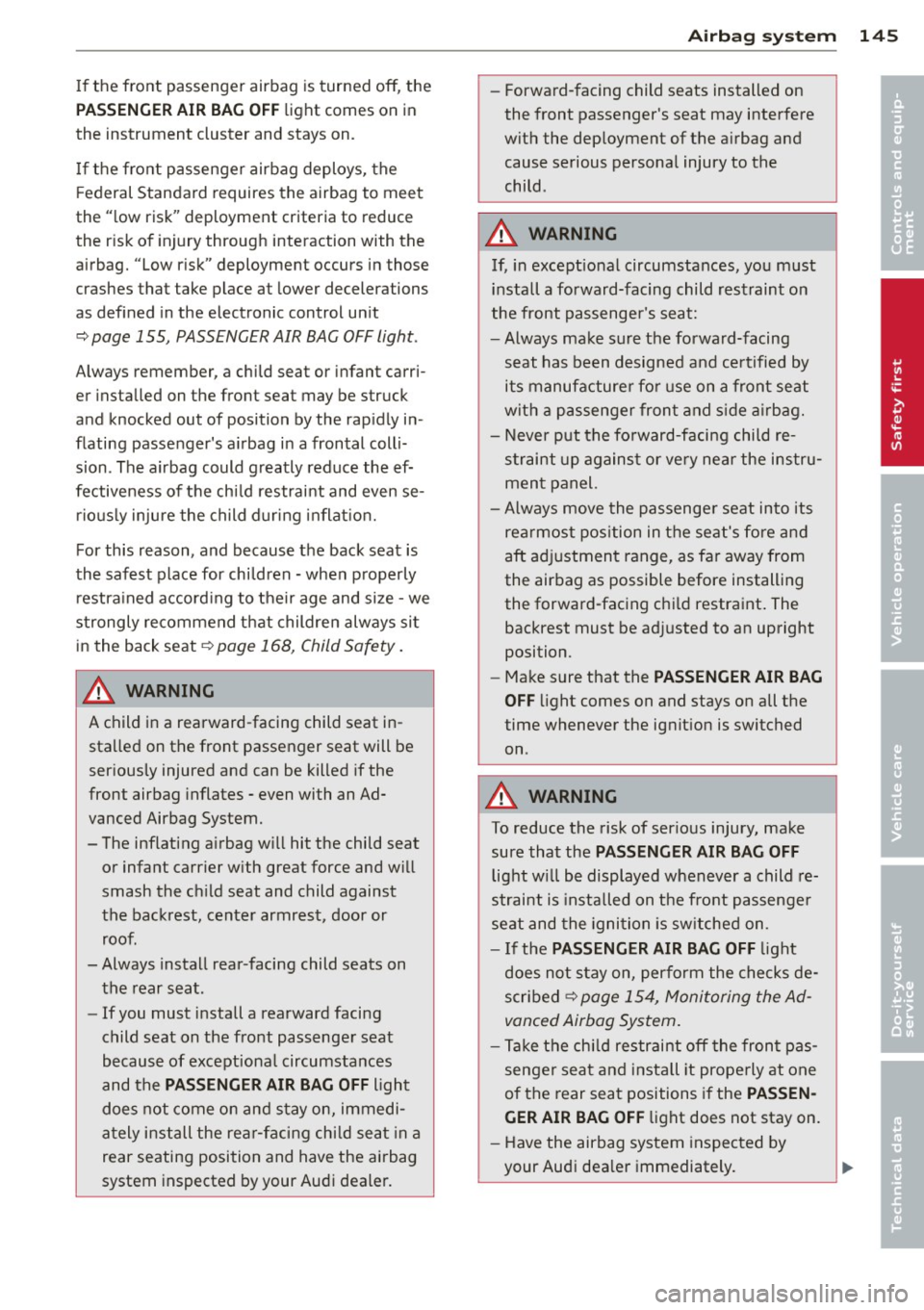
If the fron t passenger airbag is turned off, the
PA SSENGER AIR BA G OF F light comes on in
the instrument cluster and stays on.
If the front passenger airbag deploys, the
F ederal Standard requires the airbag to meet
the " low risk" deployment criteria to reduce
the r isk of injury through interaction with the
airbag. "Low r isk" deployment occurs in those
crashes that take place at lower decelerations
as defined in the electronic control un it
c::> page 155, PASSENGER AIR BAG OFF light.
Always remember, a child seat or infant carri
er installed on the front seat may be struck
and knocked out of position by the rap idly in
flating passenger's a irbag i n a frontal colli
sion . The airbag could greatly reduce the ef
fectiveness of t he ch ild restraint and even se
r io usly inju re the child d uring inflat io n.
For this reason, and because the back seat is
the safest place for chi ldren - when properly
restra ined accord ing to their age and size - we
strongly recommend that children always sit in the back seat
c::> page 168, Child Safety.
A WARNING
-
A child in a rearward -facing child seat in
stalled on the front passenger seat will be
ser iously injured and can be killed if the
front airbag inflates - even with an Ad
vanced Airbag System.
- The inflating airbag w ill hit the child seat
or infant carrier w ith great force and w ill
smash the ch ild seat and child against
the backrest, center armrest, door or roof.
- Always install rear-facing child seats on the rear seat.
- If you must install a rearward facing
child seat on the front passenge r seat
because of exceptiona l circumstances
and the
PASSENGER AIR BAG OFF light
does not come on and stay on, immedi
a tely ins tall the rea r-facing chi ld seat in a
rear seating position and have the airbag
system inspected by your Audi dealer.
A irbag system 145
-Forwa rd-facing child seats installed on
the front passenger's seat may interfere
with the dep loyment of the airbag and
cause serious persona l injury to the
child.
A WARNING
If, in except ional circumstances, you must
install a forward-facing child restraint on
the front passenge r's seat:
- Always ma ke sure the forward-facing
seat has been designed and certified by its manufacture r for use on a front seat
with a passenger fron t and s ide a irbag.
- Never put the fo rward-facing child re
s tra int up against or ve ry near the instru
men t panel.
- Always move the passenge r seat into its
rea rmost pos ition in the se at's fore and
aft ad justment range, as fa r away from
the airbag as possible before installing
the forward-fac ing ch ild restra int . The
backrest must be adj usted to an upright
position.
- Make sure that the
PASSENGER AIR BAG
OFF
li ght comes on and stays on all the
time whenever the ignition is switched on .
A WARNING
To reduce the risk of ser ious injury, make
sure that the
PASSENGER AIR BAG OFF
light w ill be displayed whenever a child re
straint is insta lled on the front passenge r
se at and the ignition is sw itched on.
- If the
PASSENGER AIR BAG OFF light
does not s tay on, perform the checks de
scribed
c::> page 154, Monitoring the Ad
vanced Airbag System.
- T ake the chi ld restraint off t he front pas
senger seat and install it prope rly at one
of the rear seat positions i f the
PASSEN
GER AIR BAG OFF
light does not stay on.
- Have the airbag system inspected by
your Aud i dea ler immediately.
•
•
Page 151 of 292
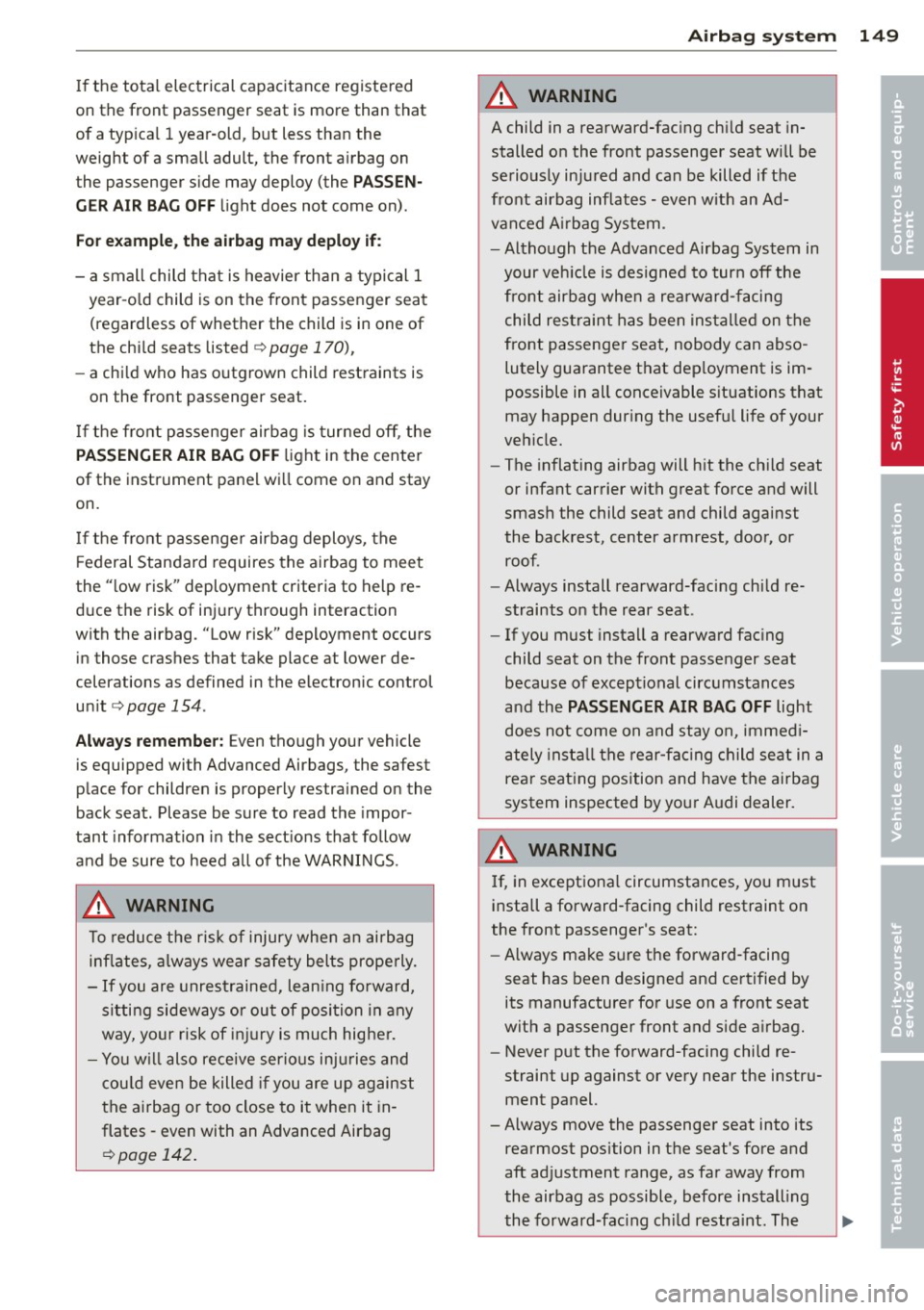
If the total electrical capacitance registered
on the front passenger seat is more than that
of a typ ica l 1 year-old, but less than the
weight of a small adult, the front airbag on the passenger side may deploy (the
PA SSEN
G ER AIR BA G OFF
light does not come on) .
For example, th e air bag m ay depl oy if :
-a small child that is heavier than a typical 1
year-o ld child is on the front passenger seat
(regardless of whether the child is in one of
the chi ld seats listed
¢ page 170),
-a chi ld who has outgrown child restraints is
on the front passenger seat.
I f the front passenger airbag is turned
off, the
PA SSENGER AIR BA G OFF light in the center
of the instrument panel wi ll come on and stay
on.
If the front passenger airbag deploys, the
F ederal Standard requires the a irbag to meet
the " low risk" deployment criteria to help re
d uce the risk of injury through interaction
with the airbag. "Low risk" deployment occurs
in those crashes that take place at lower de
celerations as defined in the electronic control
un it
o page 154 .
Alwa ys rem ember: Even though your vehicle
is equipped with Advanced Airbags, the safest
place for children is properly restrained on the
back seat. Please be sure to read the impor
tant information in the sect ions that follow
and be sure to heed a ll of the WARNINGS.
A WARNING
To reduce the risk of injury when an airbag
inf lates, a lways wear safety belts properly.
- If you are unres trained, lean ing fo rward,
sitting sideways or out of position in any
way, your risk of inj ury is much highe r.
- You w ill also receive serio us inju ries and
cou ld even be killed if you are up against
the a irbag or too close to it when it in
flates -even with an Advanced Airbag
¢ page 142 .
Airbag system 149
A WARNING
A child in a rearward-fac ing ch ild seat in
stalled on the front passenger seat will be
seriously inju red and can be killed if the
front airbag inflates -even w ith an Ad
vanced A irbag System .
- Although the Advanced Airbag System in
your veh icle is designed to turn
off the
front airbag when a rearward-facing child res traint has been installe d on the
front passenger seat, nobody can abso
lutely guarantee that dep loyment is im
possible in all conceivable situations that
may happen dur ing the usefu l life of your
veh icle.
- The inflating airbag will h it the ch ild seat
or infant carrier with great force and will
smash the child seat and child against
the backrest, center armrest, door, or roof.
- Always install rearward-facing chi ld re
straints on the rear seat .
- If you must install a rearward fac ing
child seat on the front passenger seat because of exceptional circumstances
and the
PASSENGER AIR BAG OFF light
does not come on and stay on, immed i
ately in sta ll the rear-fa cing child seat in a
rea r seat ing pos ition and have the airbag
system inspected by your Audi dealer.
A WARNING ,-
If, in except iona l circumstances, you must
install a forward-facing child restraint on
the front passenger's seat:
- Always make sure the forward-facing
seat has been designed and certified by
its manufacturer for use on a front seat
with a passenger front and s ide a irbag.
- Never put the forward-facing child re
straint up against or very near the instru ment panel.
- Always move the passenger seat into its rearmost position in the seat's fore and
aft adjustment range, as far away from
the airbag as possible, before installing
the forward-fac ing ch ild restra int . Th e •
-
•
Page 155 of 292
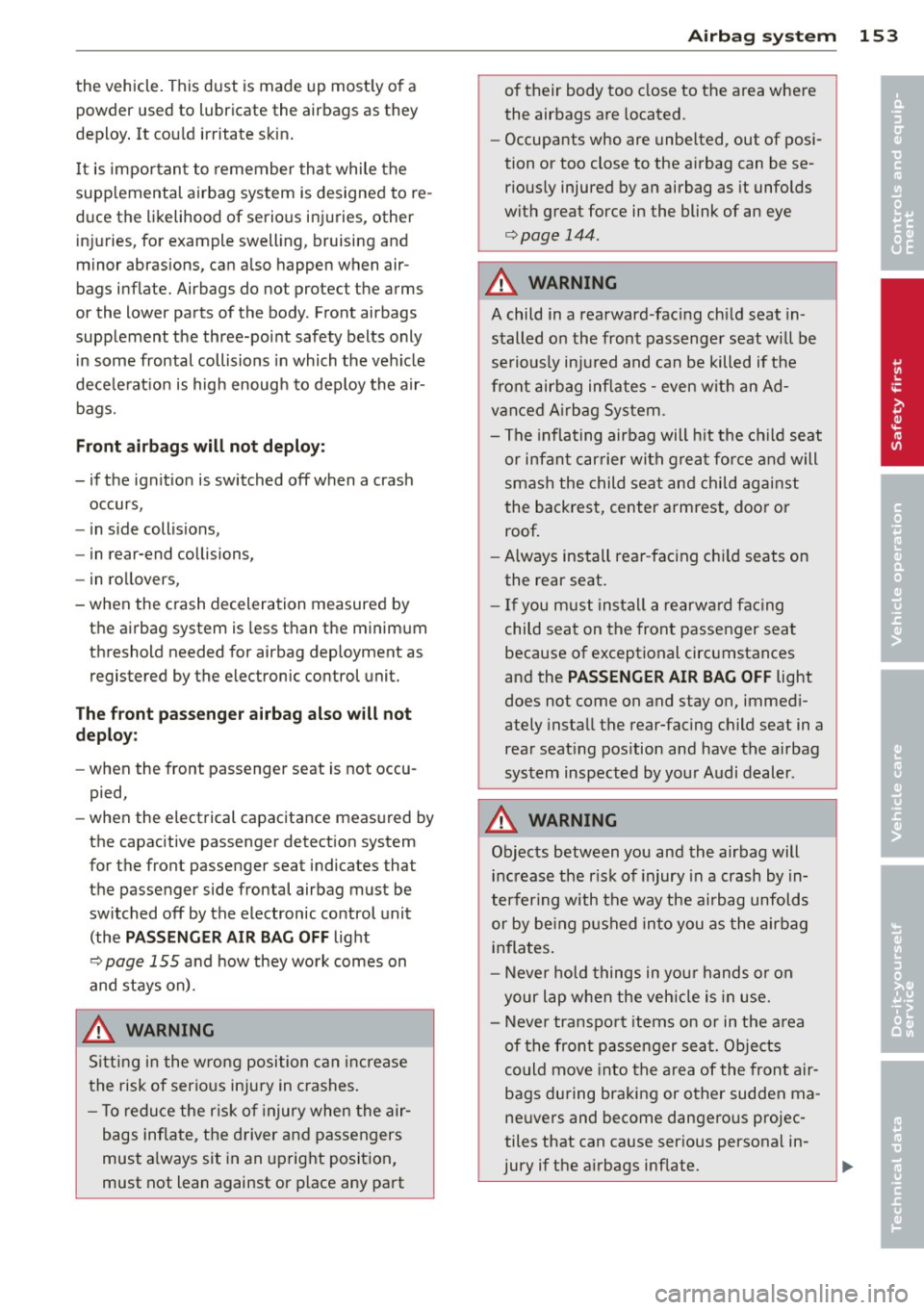
the vehicle. This dust is made up most ly of a
powder used to lubricate the airbags as they
deploy . It cou ld irritate skin .
It is importan t to remember that while the
supplemental airbag system is designed to re
duce the likelihood of serious injuries , other
in ju ries, for example swell ing, bruising and
minor abrasions, can also happen when air
bags inflate. Airbags do not protect the arms
or the lower parts of the body . Front airbags
supplement the three-poi nt safety belts only
i n some frontal collisions in which the vehicle
decelerat ion is high enough to deploy the air
bags.
Front airbags will not deploy:
- if the ignit ion is switched off when a crash
occurs,
- in s ide collisions,
- in rear-end collisions,
- in ro llovers,
- when the crash deceleration measured by
the airbag system is less than the minimum
threshold needed for airbag deployment as
registered by the electronic control unit.
Th e front pa sseng er airbag al so will not
d e plo y:
-when the front passenger seat is not occu
pied,
- when the electrical capacitance measured by
the capacitive passenger detect ion system
for the front passenger seat indicates that
the passenger side frontal airbag must be
switched off by the electronic control unit (the
P ASSENGER AIR BAG OFF light
¢ page 155 and how they wo rk comes on
and stays on).
A WARNING
Sitting in the wrong position can increase
the risk of serious injury in crashes .
- To reduce the r isk o f injury when the air
bags inflate, the driver and passengers
must a lways sit in an upright position,
must not lean against or place any part
A irbag system 153
of their body too close to the area where
the airbags are located.
- Occupants who are unbelted, out of posi
tion or too close to the airbag can be se
riously injured by an airbag as it unfolds
with great force in the blink of an eye
¢page 144.
A WARNING
A child in a rearward-fac ing ch ild seat in
stalled on the front passenger seat will be
se riously injured and can be killed if the
front airbag inflates - even w ith an Ad
vanced A irbag System.
- The inflating airbag will h it the ch ild seat
or infant carrier with great fo rce and will
smash the child seat and child against
the backrest, center armrest, doo r or
roof.
- Always install rear -facing chi ld seats on
the rear seat.
- If you must install a rearward fac ing
child seat on the front passenger seat
because of exceptional circumstances
and the PASS ENG ER AIR BAG OFF light
does not come on and stay on, immed i
ately insta ll the rear-facing child seat in a
rea r seat ing pos ition and have the airbag
system inspected by your Audi dealer .
A WARNING
Objects between you and the airbag will
increase the r isk of injury in a crash by in
terfering with the way the ai rbag unfolds
or by be ing p ushed into you as the airbag
inflates.
- Neve r hold things in yo ur hands o r on
your lap when the veh icle is in use.
- Never transpo rt items on or in the a rea
of the front passenger seat. Objects
co uld move into the area of the front air
bags during braking or other sudden ma
neuvers and become dangero us projec
tiles that can cause ser ious personal in
jury if the a irbags inf late.
•
•
-
-
Page 167 of 292
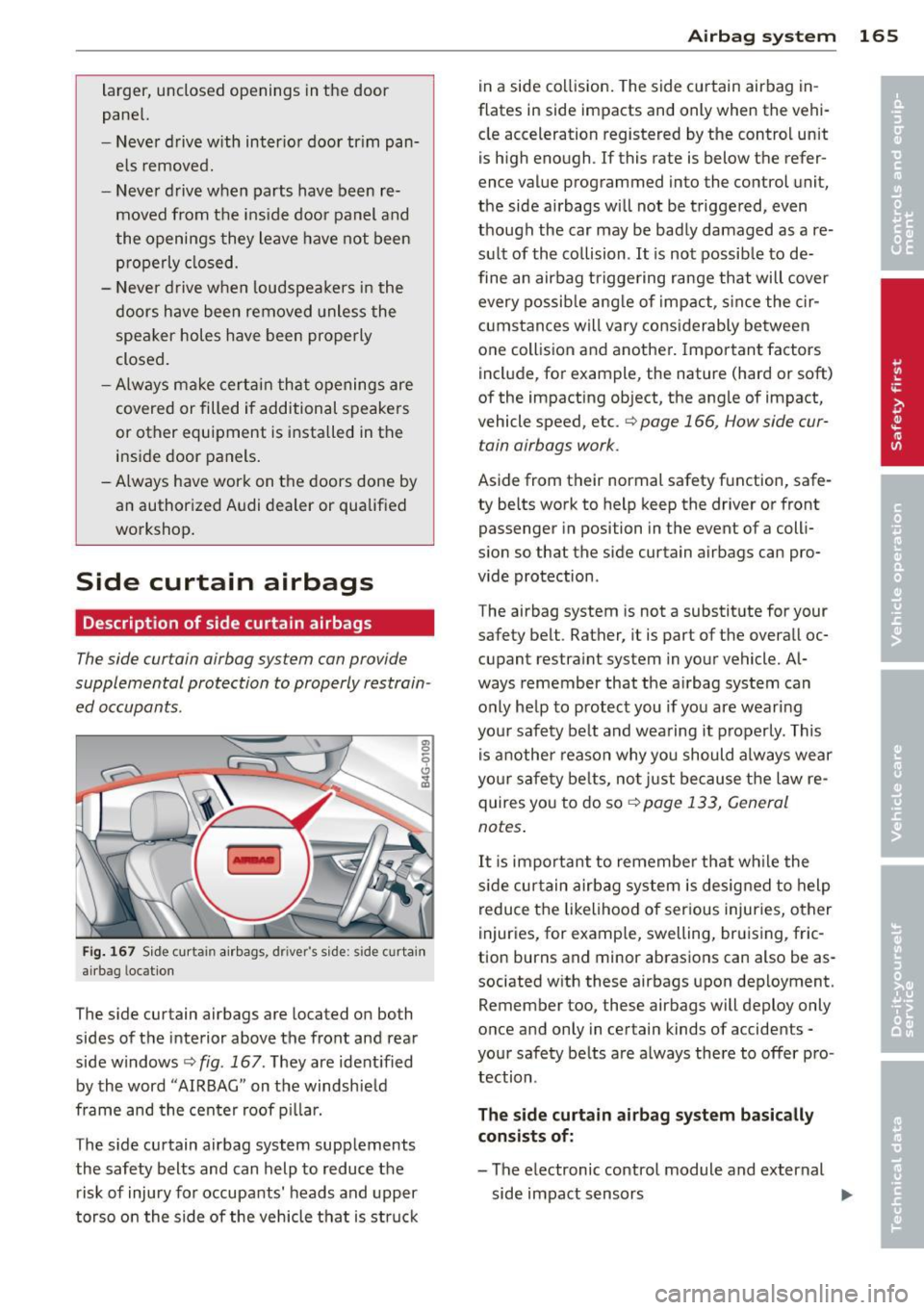
larger, unclosed openings in the door
panel.
- Never d rive w ith int erio r door tr im pan
els removed.
- Never d rive when parts have been re
moved from t he ins ide door panel and
the openings they leave have not been
properly closed.
- Never d rive w hen loudspeakers in the
doors have been removed unless the
spea ker holes have been properly
closed.
- Always make cer tai n t hat openings are
covered or filled if additional speake rs
or other equi pment is installed in the
inside door panels.
- A lways have work on t he doors done by
a n authorized Audi dealer or qualified
wo rkshop .
Side curtain airbags
Description of side curtain airbags
The side curtain airbag system can provide
supplemental protection to properly restrain
ed occupants.
Fi g. 167 Side curtai n airbags, dri ver 's s ide: side cu rtai n
ai rbag locat ion
The side curtain airbags are located on both
sides of the interior above the front and rear
side windows ¢
fig. 167 . They are identified
by the word "AIRBAG" on the windshie ld
frame and the center roof pillar.
The s ide curtain airbag system supplements
the safety belts and can help to reduce the
risk of injury for occupa nts' heads and upper
torso on the side of the veh icle tha t is struc k
Airba g system 165
in a side collision. The side cu rtain airbag in
flates in side impacts and only when the vehi
cle acceleration registered by the control un it
is h igh eno ugh. If this rate is below the refer
ence value programmed into the control unit,
the side airbags will not be triggered, even
though the car may be badly damaged as a re
sult of the co llision . It is not possib le to de
fine an airbag triggering range that will cover every possib le ang le of impa ct, sin ce the cir
c u mstances will vary cons iderably be tween
one collision and anothe r. Important factors
incl ude , for example, the nature (hard or soft)
of the impacting object, the ang le of impact,
vehicle speed, etc. ¢
page 166, How side cur
tain airbags work.
Aside from their normal safety function, safe
ty belts work to help keep the driver or front passenger in position in the event of a colli
s ion so that the side curtain airbags can pro
vide protection .
The airbag system is not a substit ute for your
safety belt. Rather, it is part of the overall oc
cupant restraint system in your vehicle. Al
ways remember that the a irbag system can
o nly help to protect you if you are wear ing
you r safety be lt and wearing it properly. This
i s a nothe r reason why you should a lways wear
your sa fe ty be lts, no t ju st because the law re
quires you to do so ¢
page 133, General
notes .
It is important to remember that wh ile the
s ide cu rtain air bag system is desig ned to help
reduce the likelihood of serious injuries, other
injur ies, for examp le, swelling, bruising, fric
tion burns and minor abrasions can also be as
sociated w ith these airbags upon dep loyment.
Remember too, these airbags will deploy only
once and only in certain kinds of accidents -
your safety belts a re always there to offer pro
tection .
The side curtain airbag sy stem basic ally
consists of :
- The electronic control module and external
side impact sensors
ll>-
Page 175 of 292
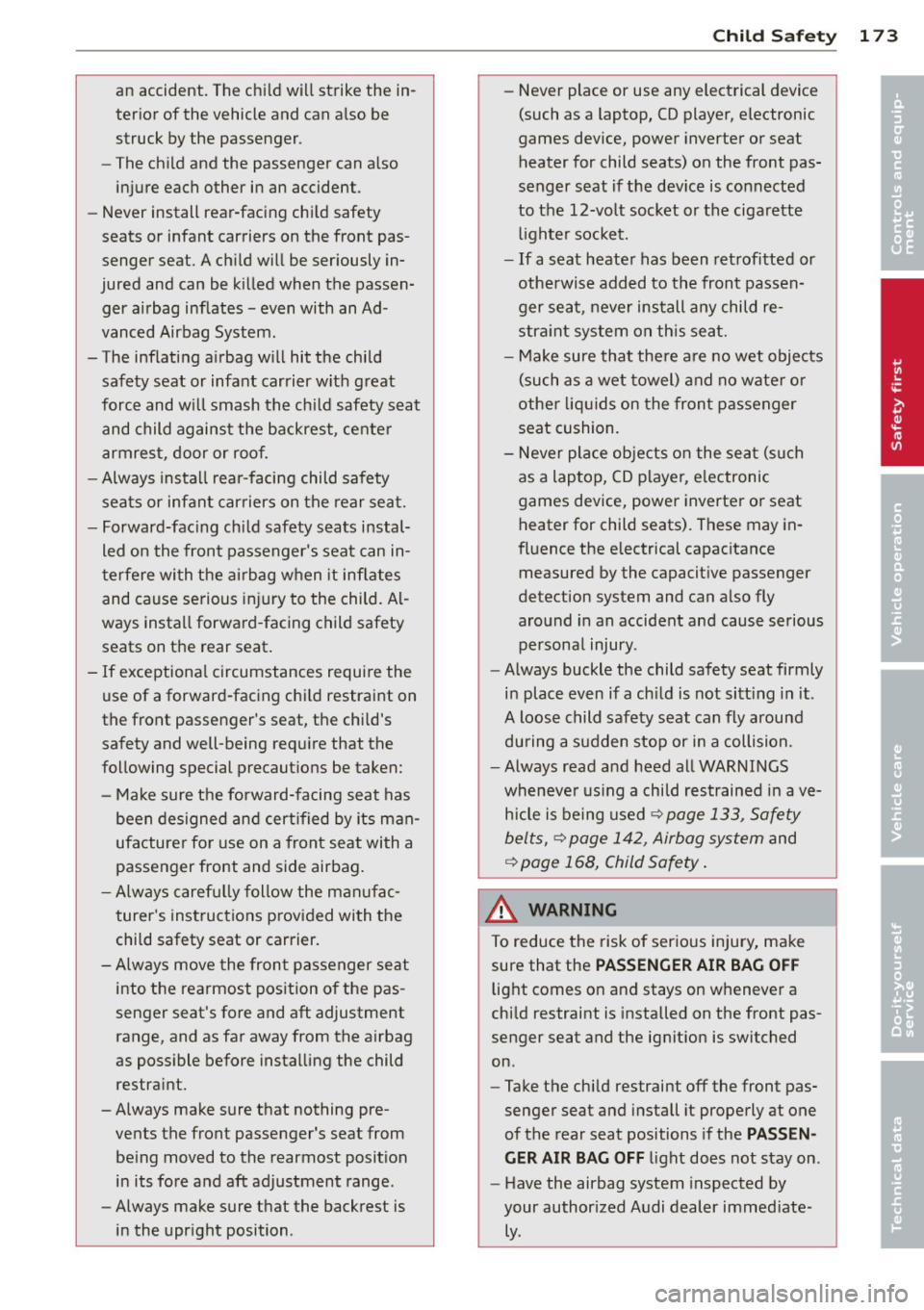
an accident. The child will strike the in
terior of the vehicle and can also be
struck by the passenger .
- The child and the passenger can also
injure each other in an accident .
- Never install rear-facing child safety
seats or infant carriers on the front pas
senger seat. A child will be seriously in
jured and can be killed when the passen ger airbag inflates - even with an Ad
vanced Airbag System.
- The inflating airbag will hit the child safety seat or infant carrier with great
force and will smash the child safety seat and child against the backrest, center
armrest, door or roof.
- Always install rear-facing child safety
seats or infant carriers on the rear seat.
- Forward-facing child safety seats instal
led on the front passenger's seat can in
terfere with the airbag when it inflates
and cause serious injury to the child. Al
ways install forward-facing child safety
seats on the rear seat.
- If exceptional circumstances require the
use of a forward-facing child restraint on
the front passenger's seat, the child's safety and well-being require that the
following special precautions be taken:
- Make sure the forward-facing seat has
been designed and certified by its man
ufacturer for use on a front seat with a
passenger front and side airbag.
- Always carefully follow the manufac
turer's instructions provided with the
child safety seat or carrier.
- Always move the front passenger seat
into the rearmost position of the pas
senger seat's fore and aft adjustment
range, and as far away from the airbag
as possible before installing the child
restraint.
- Always make sure that nothing pre
vents the front passenger's seat from
being moved to the rearmost position
in its fore and aft adjustment range.
- Always make sure that the backrest is
in the upright position .
Child Safety 173
-Never place or use any electrical device
(such as a laptop, CO player, electronic
games device, power inverter or seat
heater for child seats) on the front pas
senger seat if the device is connected
to the 12-volt socket or the cigarette
lighter socket.
- If a seat heater has been retrofitted or
otherwise added to the front passen
ger seat, never install any child re
straint system on this seat.
- Make sure that there are no wet objects
(such as a wet towel) and no water or
other liquids on the front passenger
seat cushion.
- Never place objects on the seat (such
as a laptop, CO player, electronic
games device, power inverter or seat
heater for child seats). These may in
fluence the electrical capacitance
measured by the capacitive passenger
detection system and can also fly
around in an accident and cause serious personal injury .
- Always buckle the child safety seat firmly
in place even if a child is not sitting in it.
A loose child safety seat can fly around
during a sudden stop or in a collision.
- Always read and heed all WARNINGS
whenever using a child restrained in ave hicle is being used
~ page 133, Safety
belts,
~ page 142, Airbag system and
~ page 168, Child Safety.
A WARNING
To reduce the risk of serious injury, make
sure that the
PASSENGER AIR BAG OFF
light comes on and stays on whenever a
child restraint is installed on the front pas
senger seat and the ignition is switched
on .
- Take the child restraint off the front pas
senger seat and install it properly at one
of the rear seat positions if the
PASSEN
GER AIR BAG OFF
light does not stay on .
- Have the airbag system inspected by
your authorized Audi dealer immediate
ly . •
•
Page 177 of 292
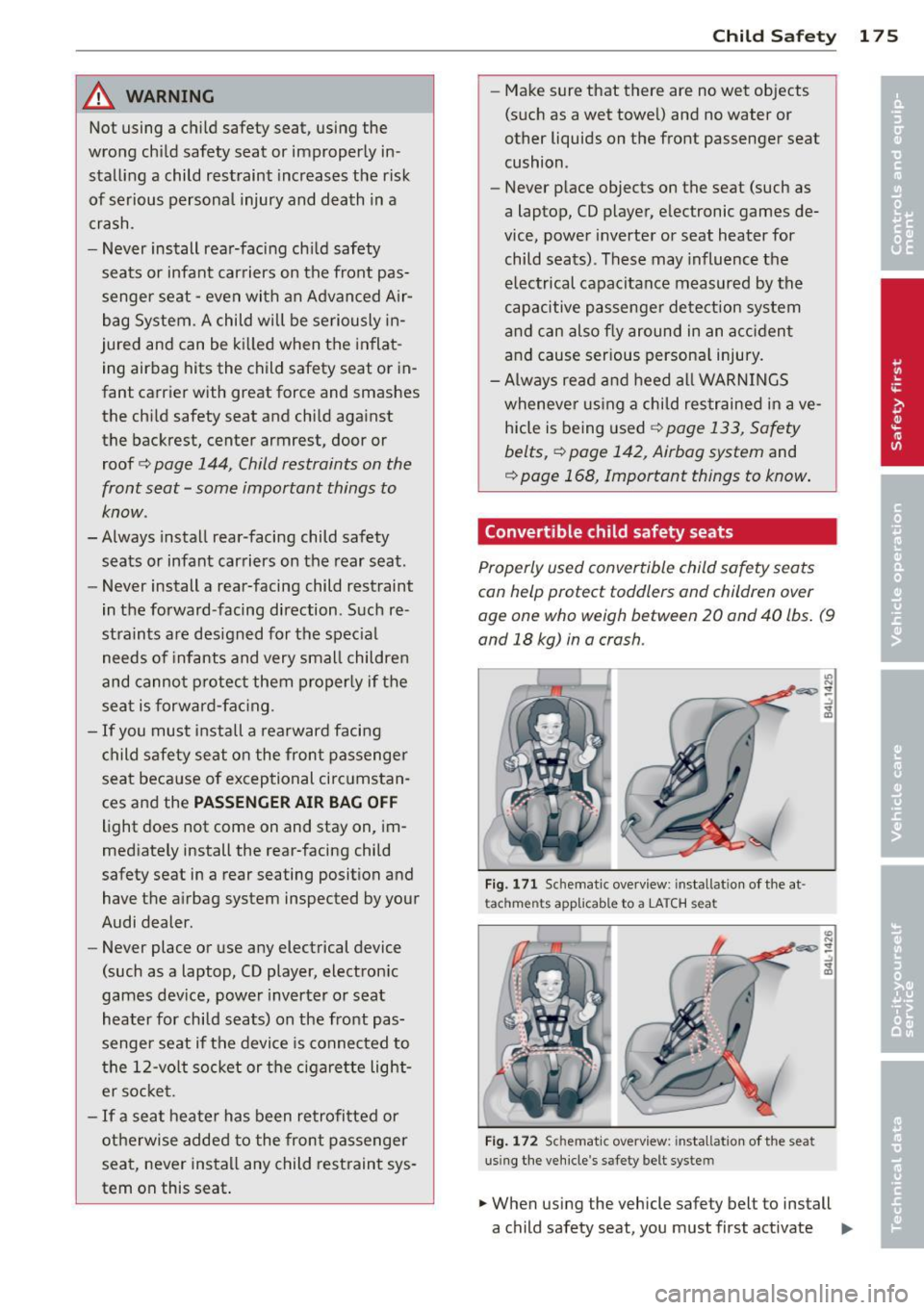
_& WARNING
Not using a child safety seat, using the
wrong child safety seat or improperly in stalling a child restraint increases the risk
of serious personal injury and death in a
crash .
- Never install rea r-facing ch ild safety
seats or infant carriers on the front pas
senger seat - even with an Advanced Air
bag System. A child wilt be seriously in
jured and can be ki lled when the inflat
ing airbag hits the child safety seat or in
fant carrier with great force and smashes
the ch ild safety seat and child aga inst
the backrest, center armrest, door or roof ¢
page 144, Child restraints on the
front seat -some important things to
know .
- Always install rear -facing child safety
seats or infant carriers on the rear seat .
- Never install a rear-facing child restraint
in the forward-facing direction . Such re
straints are designed for the spec ial
needs of infants and very small childre n
and cannot p rotect them properly if the
sea t is forward-fac ing .
-If you mus t install a rea rward faci ng
child safety seat on the fron t passenger
seat beca use of excep tional circ umstan
ces and the
PASSENGER AIR BAG OFF
light does not come on and stay on , im
mediately install the rear-facing child
safety seat in a rear seating posit ion and
have the a irbag system inspected by your
Audi dealer.
- Never place or use any electrical device
(such as a laptop, CD player, electron ic
games dev ice, power inverter or seat
heater for child seats) on the front pas
senger seat if the devi ce is connected to
the 12 -v o lt socket or the cigarette light
er soc ket .
- If a seat heater has been re trofi tted or
otherwise added to the front passenger
sea t, never ins ta ll any child rest raint sys
tem on this seat .
Child Safety 175
- Make sure that there are no wet objects
(such as a wet towe l) and no water or
other liquids on the front passenger seat
cushion .
- Never p lace objects on the seat (such as
a laptop, CD player, e lectronic games de
vice, powe r inverter or seat heater for
child seats) . These may influence the
e lectrical capacitance measured by the
capacitive passenge r detection system
a nd can also f ly around in an acc ident
and cause serious persona l injury.
- Always re ad and heed alt WAR NINGS
wheneve r using a child res trained in ave
hicle is being used ¢
page 133 , Safety
belts,
¢ page 142, Airbag system and
¢ page 168 , Important things to know .
Convertible child safety seats
Properly used conv ertibl e child saf ety s eats
can help protect toddlers and children ov er
age one who weigh between 20 and 40 lbs . (9
and 18 kg) in o crash .
Fig. 1 71 Sc hemat ic ove rv iew : instal lat ion of t he a t·
t ac hment s applicab le to a LA T CH seat
F ig . 1 72 Sc hem at ic ove rview : in sta llati oh of t he sea t
us ing the ve hicle 's s afety be lt syste m
.. When using the vehicle safe ty belt to install
a child safety seat, you must first activate ..,